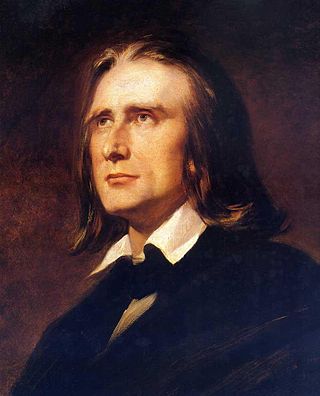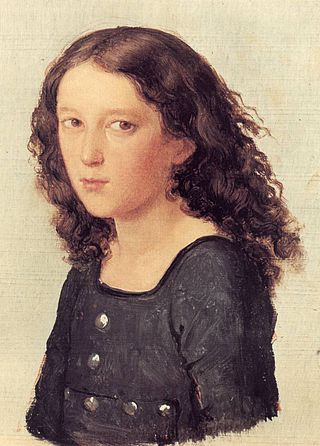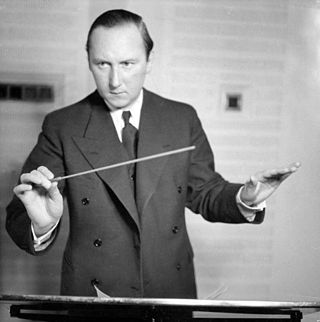Related Research Articles

Orchestration is the study or practice of writing music for an orchestra or of adapting music composed for another medium for an orchestra. Also called "instrumentation", orchestration is the assignment of different instruments to play the different parts of a musical work. For example, a work for solo piano could be adapted and orchestrated so that an orchestra could perform the piece, or a concert band piece could be orchestrated for a symphony orchestra.

Music for Strings, Percussion and Celesta, Sz. 106, BB 114 is one of the best-known compositions by the Hungarian composer Béla Bartók. Commissioned by Paul Sacher to celebrate the tenth anniversary of the chamber orchestra Basler Kammerorchester, the score is dated September 7, 1936.
The Cello Concerto No. 1 in E-flat major, Op. 107, was composed in 1959 by Dmitri Shostakovich. Shostakovich wrote the work for his friend Mstislav Rostropovich, who committed it to memory in four days. He premiered it on October 4, 1959, at the Large Hall of the Leningrad Conservatory with the Leningrad Philharmonic Orchestra conducted by Yevgeny Mravinsky. The first recording was made in two days following the premiere by Rostropovich and the Moscow Philharmonic Orchestra conducted by Aleksandr Gauk.
The Cello Concerto in A minor, Op. 129, by Robert Schumann was completed in a period of only two weeks, between 10 October and 24 October 1850, shortly after Schumann became the music director at Düsseldorf.

The Symphony No. 7 in C major, Op. 105, is a single-movement work for orchestra written from 1914 to 1924 by the Finnish composer Jean Sibelius.
Howard While Skempton is an English composer, pianist, and accordionist.
The Young Person's Guide to the Orchestra, Op. 34, is a 1945 musical composition by Benjamin Britten with a subtitle Variations and Fugue on a Theme of Purcell. It was based on the second movement, "Rondeau", of the Abdelazer suite. It was originally commissioned for the British educational documentary film called Instruments of the Orchestra released on 29 November 1946, directed by Muir Mathieson and featuring the London Symphony Orchestra conducted by Malcolm Sargent; Sargent also conducted the concert première on 15 October 1946 with the Liverpool Philharmonic in the Philharmonic Hall, Liverpool, England.

The Symphony No. 3 in C major, Op. 52, is a three-movement work for orchestra written from 1904 to 1907 by the Finnish composer Jean Sibelius.

The Variations and Fugue on a Theme by Mozart, Op. 132, is a set of variations for orchestra composed in 1914 by Max Reger; the composer conducted the premiere in Berlin on 5 February 1915. He later produced a version for two pianos, Op. 132a, where the Variation 8 ("Moderato") is completely different.

Les préludes, S.97, is the third of Franz Liszt's thirteen symphonic poems. The music was composed between 1845 and 1854, and began as an overture to Liszt's choral cycle Les quatre élémens, then revised as a stand-alone concert overture, with a new title referring to a poem by Alphonse de Lamartine. Its premiere was on 23 February 1854, conducted by Liszt himself. The score was published in 1856 by Breitkopf & Härtel. Les préludes is the earliest example of an orchestral work entitled "Symphonic Poem".
The Symphony No. 3 by Arnold Bax was completed in 1929. It was dedicated to Sir Henry Wood and is perhaps the most performed and most immediately approachable of Bax's symphonies.
The Concerto Fantasy for Two Timpanists and Orchestra is a double timpani concerto written by Philip Glass in 2000. It is paired with the Cello Concerto on Vol. I of Glass' Concerto Project, a set of eight concerti by the composer. A typical performance of the work lasts 25–28 minutes. It was written for Jonathan Haas and later recorded by Evelyn Glennie, and was premiered by Haas and Svet Stoyanov with the American Symphony Orchestra in Avery Fisher Hall, Lincoln Center, conducted by Leon Botstein. The work was commissioned jointly by the American Symphony Orchestra, the Peabody Symphony, the Milwaukee Symphony, the St. Louis Symphony and the Phoenix Symphony. In 2004, a transcription for wind ensemble was written by Mark Lortz, which debuted at Peabody Institute in 2005.
Aaron Copland wrote the Symphony for Organ and Orchestra in 1924. It represents a major work in the composer's oeuvre, as it was his first fully realized orchestral work, his first work for organ, and the first piece whose orchestration he heard. It was premiered on January 11, 1925, in New York. In 1928, Copland re-orchestrated the work without organ as his Symphony No. 1, rewriting the organ part in the brass and adding saxophone.

The Concerto for Piano, Violin, and Strings in D minor, MWV O4, also known as the Double Concerto in D minor, was written in 1823 by Felix Mendelssohn when he was 14 years old. This piece is Mendelssohn's fourth work for a solo instrument with orchestral accompaniment, preceded by a Largo and Allegro in D minor for Piano and Strings MWV O1, the Piano Concerto in A Minor MWV O2, and the Violin Concerto in D minor MWV O3. Mendelssohn composed the work to be performed for a private concert on May 25, 1823 at the Mendelssohn home in Berlin with his violin teacher and friend, Eduard Rietz. Following this private performance, Mendelssohn revised the scoring, adding winds and timpani and is possibly the first work in which Mendelssohn used winds and timpani in a large work. A public performance was given on July 3, 1823 at the Berlin Schauspielhaus. Like the A minor piano concerto (1822), it remained unpublished during Mendelssohn's lifetime and it wasn't until 1999 when a critical edition of the piece was available.

Richard Strauss composed his Symphony No. 1 in D minor in 1880 when he was just 16 years old. It consists of four movements, and lasts about 34 minutes. Although Strauss did not give a number to the symphony, it is often referred to as his First Symphony. It was premiered on 30 March 1881 at the Munich Academy of Music under the baton of Hermann Levi.
Improvisations on an Impromptu of Benjamin Britten is an orchestral piece by William Walton. It was first performed by the San Francisco Symphony Orchestra, conducted by Josef Krips, on 14 January 1970. Its European premiere was at Benjamin Britten's Aldeburgh Festival in June of that year. The work has subsequently been recorded for commercial release.
Russian composer Alfred Schnittke's Symphony No. 8 was composed in 1994. Its dedicatee Gennady Rozhdestvensky conducted the Royal Stockholm Philharmonic Orchestra in the symphony's premiere in Stockholm on 10 November 1994.
The Symphony No. 2, or 'Cello Symphony is a composition for orchestra by the American composer Ellen Taaffe Zwilich. The work was composed in 1985 on a commission from the San Francisco Symphony. It was first performed on November 13, 1985, by the San Francisco Symphony under the direction of Edo de Waart, to whom the piece is dedicated.

The Violin Concerto, Op. 54, is a three-movement concertante composition for violin and orchestra written in 1952 by the Swedish composer Lars-Erik Larsson. The piece premiered over Swedish Radio on 11 January 1953 in Stockholm, Sweden, with Sten Frykberg conducting the Swedish Radio Orchestra. The soloist was the Hungarian violinist André Gertler, its dedicatee.
References
- Lento at the Oxford University Press website
- Keith Potter. Howard Skempton: Some Clues for a Post-Experimental "Movement", The Musical Times, cxxxii (1991), pp. 126–30.